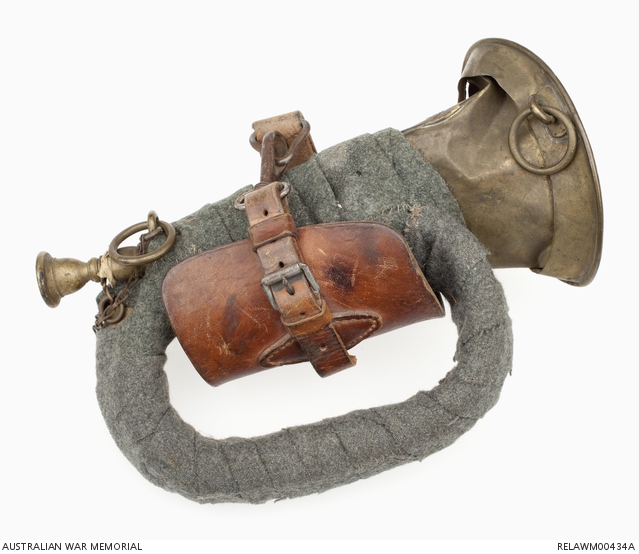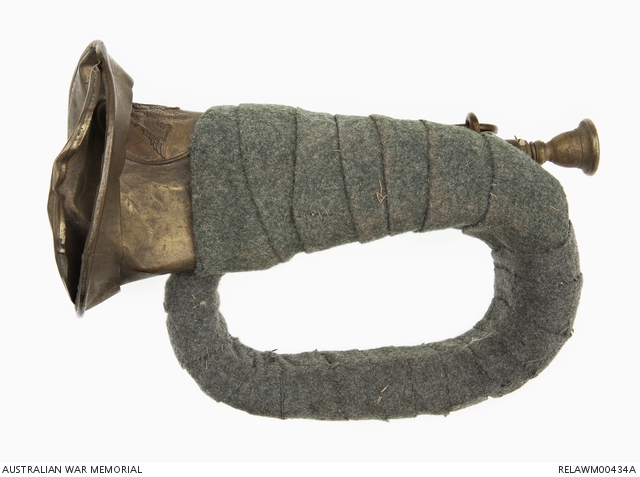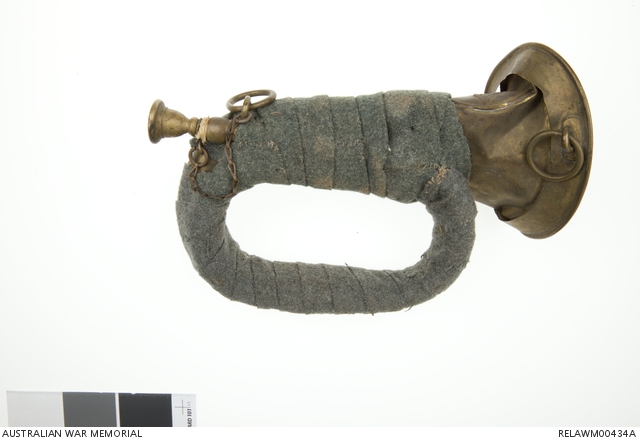| Place | Middle East: Ottoman Empire, Palestine, Musallabeh |
|---|---|
| Accession Number | RELAWM00434A |
| Collection type | Heraldry |
| Object type | Heraldry |
| Physical description | Brass, Felt, Iron, Leather |
| Location | Main Bld: First World War Gallery: Sinai Palestine 1918: Semakh |
| Maker |
Sprinz, Arthur |
| Place made | Germany: Berlin |
| Date made | Unknown |
| Conflict |
First World War, 1914-1918 |
German bugle: Captain F Evans, 2 Light Horse Regiment, AIF



Battle damaged brass bugle provided with a pair of brass suspension loops soldered to the body at the mouthpiece and bell. A brass chain links mouthpiece to body. The bugle is inscribed with the maker's details, 'A Sprinz, Berlin'. A substantial part of the bugle body has been carefully wrapped in strips of field grey wool uniform fabric, sewn at the top to secure it in place. Attached to the bugle is a buckled brown leather carrier with an integral black iron equipment fastener to be attached to the lower coil of the bugle.
German infantry bugle taken from the body of a German bugler who fell in the attack at Musallabeh on 11 April 1918.
On that day a large Turkish force attacked the Imperial Camel Corps (ICC) defences on the Wadi Nimrin and in the hills at Musallabeh. During a patrol by the 2nd Light Horse Regiment at 4:30AM, a Turkish unit of around 100 troops were found on the left bank of the Wadi Nimrin. By dawn one thousand infantrymen approached the Division's defences, getting to within one hundred yards (91 m) of the barbed wire defences before the Division's guns opened fire. At this stage the Turkish numbers had increased to an estimated two thousand.
At 1PM Brigadier-General Charles Frederick Cox, General Officer Commanding of the 1st Light Horse Brigade, ordered the 1st and 3rd Light Horse Regiments to ride out and encircle them. However they were outnumberd both in men and machine-guns, so could not approach. Sporadic firing continued all night but by 4:00AM on 12 April the Turkish force had withdrawn.
At 4:30AM the crossing at Musallabeh was subjected to a heavy artillery barrage. The infantry followed closly behind. At 5:00AM the barrage lifted and the Turkish infantry attacked the outnumbered Camel Corps and its attached light horse regiments. Fighting broke out and lasted until 8:00AM when the attack petered out. The Turkish forces mounted another attack in the afternoon, which also failed and forced their withdrawal.